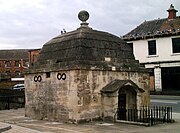
Lock-up in Breedon on the Hill, Leicestershire

Interior cell of lock-up in Lacock, Wiltshire
Village lock-ups are historic buildings that were used for the temporary detention of people in rural parts of England and Wales. They were often used for the confinement of drunks who were usually released the next day or to hold people being brought before the local magistrate. A typical village lock-up is a small structure with a single door and a narrow slit window or opening. Most lock-ups feature a dome or spire shaped roof and are commonly built from brick, large stones or timber. The village lock-up can either be round or polygonal in plan and minor variations in design, materials and appearance do occur although they were all built to perform the same function. Village lock-ups have acquired a range of local nicknames including blind-house, bone-house, bridewell, cage, jug, kitty, lobby, guard-house, round-house, tower and watch-house.
Rise of the village lock-up[]

Lock-up in Hilperton, Wiltshire
The majority of surviving village lock-ups date from the 18th and 19th centuries when rural communities struggled to police thefts, burglaries, shootings, drunkenness, the obstruction of watchmen and the stealing of livestock. During this period a number of lock-ups were built as a place of detention for local rogues and miscreants until they could be removed to a town. Over time they became synonymous with drunkenness and many references to this coupling can be found in famous works of literature, including Barnaby Rudge by Charles Dickens, and The Water Babies by Charles Kingsley which contains the following line:
'Put him in the round house till he gets sober.’Template:Ref
An 1830 description of a lock-up in Taunton describes:
'. . . a hole into which drunken and bleeding men were thrust and allowed to remain until the following day when the constable with his staff of office take the poor, crippled and dirty wretches before a magistrate, followed by half the boys and idle fellows of the town.’Template:Ref
Some lock-ups also had stocks, ducking stools, pillories, or pinfolds alongside them and the origins of the 18th century village lock-up evolved from much earlier examples of holding cells and devices.
The Oxford English Dictionary, for example, refers to a round-house as a place of detention for arrested persons and dates its first written usage to 1589.Template:Ref
In 1281 a structure similar to a common village lock-up (the Tun) was erected in Cornhill, central London. It was a two-storey barrel shaped design and had a single cell on each floor.Template:Ref
Decline and later uses[]

Lock-up in Trowbridge, Wiltshire
The village lock-up fell out of use when the County Police Act was introduced in 1839 and local police stations were built with their own holding facilities. The Act allowed Justices of the Peace to set up a paid police force in each county and made it compulsory for that force to be provided with proper police stations and secure cells. The village lock-up became a redundant edifice as a result and only a small fraction have survived the intervening century and a half.
During World War II many lock-ups were used by the Home Guard as sentry posts or places for storing arms.
In recent years a number of village lock-ups have been restored, and graded as listed buildings. Some are regarded as local heritage attractions while others remain in a ruinous state or have been converted into private buildings.
There is no official register of these structures and their locations.
Notable village lock-ups[]
The crest of Everton Football Club features a round-house based on Prince Rupert's Tower which still stands on Everton Brow, Liverpool.
D. H. Lawrence and his German-born wife Frieda had to report to the lock-up in Wirksworth during the First World War when they lived at Middleton-by-Wirksworth.
The roof of Castle Cary lock-up is reputed to have inspired the design of the modern British police helmet.
Existing lock-up locations in England and Wales[]
(An asterisk is used to denote lock-ups that have been assimilated into other buildings such as a church or house.)
- Bedfordshire
Clophill, Harrold, Silsoe
- Berkshire
Pangbourne
- Buckinghamshire
Wendover*
- Cambridgeshire
Broughton, Eaton Socon, Fenstanton, Needingworth
- Cheshire
Widnes
- Derbyshire

The lockup in Smisby
Curbar, Cromford, Derwent Valley Mills*, Sandiacre, Smisby, Ticknall, Wirksworth*
- Essex
Bradwell on Sea, Great Bardfield, *Orsett, Steeple Bumpstead, Tollesbury
- Gloucestershire

Bisley, Gloucestershire lockup
Bisley, Cirencester, Westerleigh*
- Greater London
Petersham
- Hampshire
Easton (ruin), Odiham
- Hertfordshire
Anstey, Ashwell, Barley, Shenley
- Kent
Dartford, Lenham, Wateringbury
- Leicestershire
Barrow-upon-Soar, Breedon-on-the-Hill, Packington, Worthington
- Lincolnshire
Deeping St James, Digby
- Merseyside
Everton, Wavertree, Woolton
- Nottinghamshire
Edwinstowe, Mansfield Woodhouse, Tuxford
- Oxfordshire
Stonesfield, Wheatley
- Somerset
Castle Cary, Kingsbury Episcopi, Monkton Combe, Pensford, Nunney, Frome
- Staffordshire
Alton, Gnosall
- Suffolk
Sproughton, Woolpit
- Surrey
Charlwood, Ewell, Lingfield
- Wiltshire
Box, Bradford-on-Avon, Bromham, Hilperton, Lacock, Shrewton, Steeple Ashton, Trowbridge
- Yorkshire
Oswaldkirk, Wath-upon-Dearne, North Stainley, Snaith
- Clwyd
Ruabon
- Flintshire
Bagillt
- Gwynedd
Barmouth
See also[]
- Bridewell Palace
Notes[]
- Template:Note Kingsley, Charles. The Water-Babies, A Fairy Tale for a Land Baby.
- Template:Note The Round House Worthington, Worthington Parish Council Pamphlet, produced by North West Leicestershire District Council.
- Template:Note Oxford English Dictionary.
- Template:Note 'Cornhill, Gracechurch Street, and Fenchurch Street', Old and New London: Volume 2 (1878), pp. 170-183.
External links[]
| Wikimedia Commons has media related to Village lock-ups that may be added |
- Smisby Village Online Website
- Bisley Village Online Website
- Bagillt Heritage Society
- Photos of village lock-ups in the UK on www.geograph.org.uk
Further reading[]
- Juliet Shipman, The Bisley Lock-up: A story of crime and punishment
- Plumridge, Andrew The National Directory of Village Lock-Ups, Stocks, Pillories, Gallows, Gibbets, Pounds and Pinfolds, and Other Pre-Police Force Punishment and Detention Devices